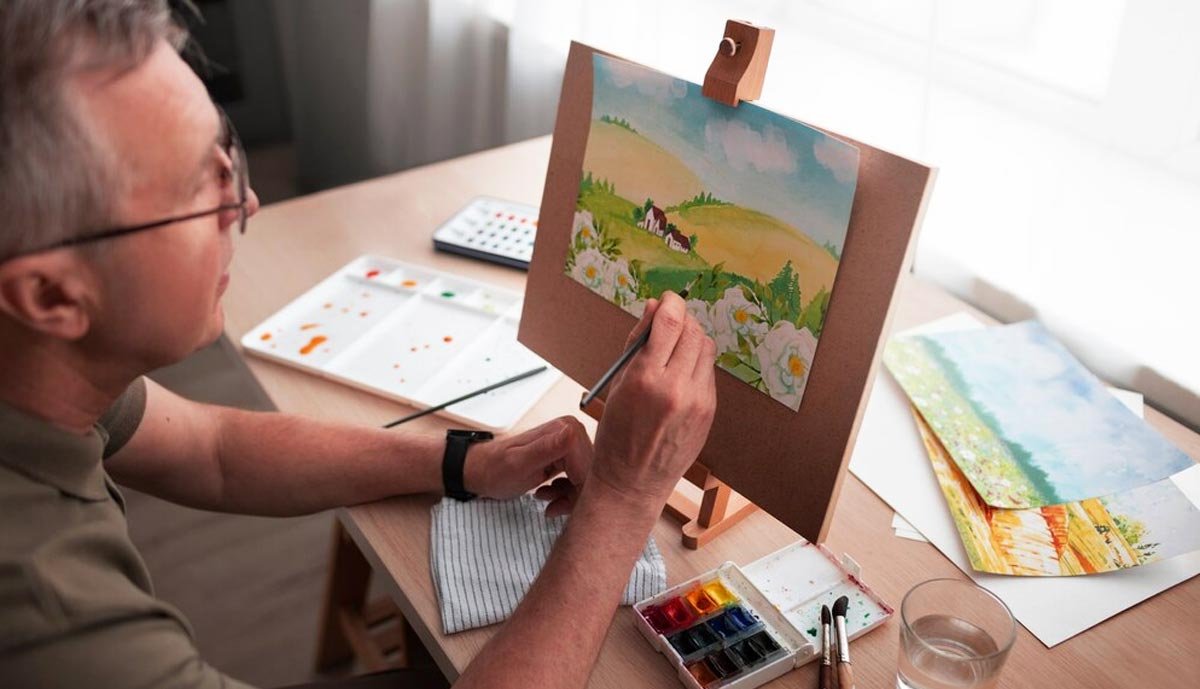Guide
Five Ways To Make Your Pictures And Artwork Authentic
Published
1 year agoon
By
Admin
Imagine yourself as a vlogger who travels far and wide to click the perfect image of a scenery. You take all the necessary steps to make the picture stand out but you are left with a sour taste in your mouth when your visually stunning creation gets stolen by other netizens from your online portfolios.
Millions of people become victims of copyright infringement. Millions of people across the world find themselves in such situations every year. Approximately 419 cases were registered with the Copyright Claims Board (CCB) in the United States last year, whereas 481,038 complaints were filed in the U.S. Copyright Office.
It is becoming easier for people to collect and engage in artwork trade thanks to the internet, but cybercriminals are also rampant in their activities by creating fakes, forgeries, and questionable works of art that are being produced and offered for sale in record numbers. This is happening regardless of art forms, price range, and artistry level.
You can make it tough for these miscreants to fake, doctor, or otherwise misrepresent bogus works of art that were originally created by you. Here is a list of things that authenticates and protects your art, and makes sure it is recognized as yours.
Obtaining a Certificate of Authority
This is the top tool in determining an artwork’s provenance, is a declaration that the artwork belongs to you, and provides a record of sale for you and the buyer.
You should obtain a Certificate of Authenticity (CoA) because it builds trust and professionalism in the art market. This document guarantees that the subject creation is genuine and belongs to you and this increases its value and legitimacy among buyers, collectors, and illustrators.
You showcase your commitment to authenticity with this document which works in your favor. It protects you from fraud and scams and reassures collectors that they are making the right investment.
A comprehensive CoA sets you apart in the industry. It is a tangible representation of your artistic integrity which creates stronger relationships with clients and art enthusiasts. It lets you be heard in the business and confirms your creations are valued.
Build a Strong Professional Network
Artists with an active presence in the art community have a trusted network of fans and fellow visual artists who can vouch for them when their content comes under question. You can get in touch and build a repertoire by visiting fairs, galleries, and seminars.
You can partner with other artists, galleries, and art organizations for legal resources and potential avenues to address copyright issues, along with honing your skills and making your content aesthetically pleasing. You can share views on copyright and intellectual property rights to shed light on these concerns among aspiring and professional artists.
This helps you create a network where fellow artists share views similar to yours.
Visual artists can use resources to protect their work. The Artists Rights Society or the Graphic Artists Guild are leading organizations that guide members on copyright issues and legal assistance and advocate for their members’ rights.
Have A Secure Digital Presence
This is especially important if you showcase your creations online. Your website and portfolio should be secure. A visual artist may use HTTPS encryption services to protect data that is transmitted between your website and visitors and prevent unauthorized access and potential theft of your digital files.
Artists can use lower-resolution images for online display and disable right-click functionality or use image protection plugins on their websites. You can use Digital Rights Management (DRM) to stop digital files from getting copied, shared, or used, which drives authentic downloadable content and digital prints.
You can also update your website’s security features and monitor for any vulnerabilities regularly. Set strong passwords, enable two-factor authentication, and use the latest version of the software to stay secure.
Use Watermarks and Digital Signatures
They are imprints that declare ownership and restrict unauthorized use of your works. You clarify that the work is protected by copyright by including them in your images.
Watermarks are effective for digital artworks and photographs, as they make it more difficult for others to use or distribute your work without permission. They are usually semi-transparent and strategically placed in a way that the main elements in the artwork are not obscured. It aims to make unauthorized use less appealing without detracting from the visual impact of your work.
The same thing applies to a digital signature or digital signature logo. It is a code in digital files that verifies the authenticity and ownership of your artwork. The digital signatures are less intrusive but serve a similar purpose in proving ownership compared to watermarks. They are useful for verifying ownership in online and digital platforms.
You can create customized digital watermarking and signature features on your software. This involves embedding metadata that contains information about the creator and copyright notice. You should remember that digital signatures should be securely stored and remain effective.
Use Image Recognition Software and Metadata to Your Advantage
Metadata is the detailed information regarding the creation’s maker, name, copyright status, and creation date. You create a permanent record of ownership, assert your rights, and prove authorship by including them in your digital artwork.
You can add metadata to your files through the property and information sections of picture and video-editing software. You should make sure that copyright notices, contact information, and licensing terms sections are filled out.
Apart from metadata, image recognition technology such as Google Reverse Image Search and TinEye tracks unauthorized uses of your artwork.
You can use these services to look for unauthorized use of your artwork and take necessary actions such as contacting the infringing party or seeking legal recourse. This proactive approach protects your work from widespread misuse.
Conclusion
These proactive steps will help you protect your artwork from copyright infringement and let you reassert your rights as an owner and prevent infringement. You can ensure that your artwork is respected, remains secure, and is held in high regard.
You may like


The Ultimate Guide to Choosing the Perfect Body Moisturiser for Radiant Skin

Miles Xavier Tate: The Quiet Son of Hollywood’s Larenz Tate

Krista Visentin: The Private Life of David Visentin’s Wife

Aaron Hernandez: A Glimpse into His Life, Legacy, and the Intriguing Story of Aaron Hernandez’s House

From Research to Results: How Legal AI Supports Lawyers

Jody Morrill Wolcott: The Quiet Woman Behind Johnny Carson’s Early Life

Orthodontic Treatment Options Every Patient Should Know

How to Plan a Short Wellness Escape Without Long Travel

Quick and Reliable Solutions for Your Moving Needs

What Businesses Should Know About Post-Quantum Readiness

Revolutionizing Healthcare: The Emergence of AI-Driven Analytics

Carol Kirkwood’s Journey: Her Real Age, Husband, Career, and More

How Machine Learning and AI are Redefining the Future?

Aliza Barber: Meet Lance Barber’s Wife, Age, Life, Profile, Career and Net Worth

Evelyn Melendez: Jordan Knight’s Wife Bio, Marriage, Family, Career and Net Worth

Ilan Tobianah Biography: Family, Marriage, Lifestyle, Career and Net Worth

King Von’s Autopsy Report: The Truth Behind the Tragic Death

Who was Alice Marrow? Everything to Know About Ice-T’s and His Mother

Body Positivity and Bodycon: Embrace Your Shape with Homecoming Dresses

Meet Otelia Cox: The Supportive Wife of Tony Cox – A True Fairy Tale Romance

The Ultimate Guide to Choosing the Perfect Body Moisturiser for Radiant Skin

Miles Xavier Tate: The Quiet Son of Hollywood’s Larenz Tate

Krista Visentin: The Private Life of David Visentin’s Wife

Aaron Hernandez: A Glimpse into His Life, Legacy, and the Intriguing Story of Aaron Hernandez’s House

From Research to Results: How Legal AI Supports Lawyers

Jody Morrill Wolcott: The Quiet Woman Behind Johnny Carson’s Early Life

Orthodontic Treatment Options Every Patient Should Know

How to Plan a Short Wellness Escape Without Long Travel

Quick and Reliable Solutions for Your Moving Needs

What Businesses Should Know About Post-Quantum Readiness
Category
Trending
-

 Health2 years ago
Health2 years agoRevolutionizing Healthcare: The Emergence of AI-Driven Analytics
-

 News5 months ago
News5 months agoCarol Kirkwood’s Journey: Her Real Age, Husband, Career, and More
-

 Technology2 years ago
Technology2 years agoHow Machine Learning and AI are Redefining the Future?
-

 Celebrity2 years ago
Celebrity2 years agoAliza Barber: Meet Lance Barber’s Wife, Age, Life, Profile, Career and Net Worth
